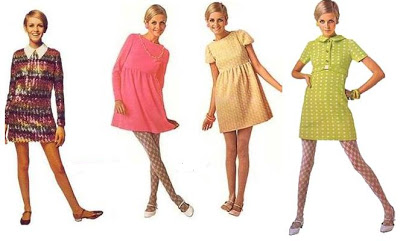She’s Got Legs ~ Stockings (First Installment)
By MICHELLE METENS
Few garments exude sex appeal the same way stockings do. Their vintage look, distinctive fit, and slinky feel appeal to us on multiple levels of sensuality. They are both classic and exotic, romantic and saucy, with the slightest glimpse of a lacy welt enough to raise a man’s blood pressure!
The stocking’s history is almost as intriguing as the item itself. Predecessors to the modern stocking date back to the Greeks and were worn in some form or another for thousands of years by a range of cultures spanning from Spain to China. In 1563 English Rev. William Lee invented a loom that allowed for mass production of knitted silk stockings as preferred by Queen Elizabeth, ushering in the knit and back seamed stocking that is the true forerunner to the modern garment.

On the left, stockings belonging to Elizabeth I, on the right, hosiery worn by her jester.
Stockings as we now know them got a kick start in the early part of the 20th century. With the shortening of skirts during the 1910s and the carefree youthful styles of the ’20s, women and certainly men too, began to pay more attention to their legs. The thick and matronly black or white stockings of the 19th century were swapped for styles that were sheerer and offered in a multitude of colors and designs. During this period women abandoned bulky corsets and girdles in favor of lightweight knickers and switched to individual leg garters to hold up their hosiery. At that time stockings began to be regarded with a certain eroticism that persists today.

Sheer, lightweight hosiery of the 1920’s was held securely to the leg with decorative or roll on style individual garters.
But the stocking revolution really took off in the ’30s. In 1935, while working at the Du Pont laboratories, American scientists Julian Hill and William Carothers (who we discussed in our previous article) invented a synthetic fiber which was called Polymer 6.6. This filament was supple and sheer, proving to be a remarkable alternative to silk. At the 1939 World’s Fair Du Pont’s vice president Charles Stine introduced the material, renamed Nylon after the event’s New York locale, to a group of three thousand woman who welcomed the cutting edge advance in hosiery enthusiastically. In 1940 nylons were available commercially for the first time and women all over the country lined up to get their hands on a pair’


Women lining up to get their hosiery on!
When the United States entered WWII in ’41 all resources were diverted to the war efforts. Both silk and nylon were used to make parachutes and tents so stockings became a scarcity on the home front. Women sufficed by tinting their legs with dye and drawing seams up the back to create the illusion of hosiery. Talk about making do! Once the war came to a close, nylon became available again and women once more flocked to shops to pick up the stockings that were being publicized for their strength, comfort and modernity.

Classic nylons were Fully Fashioned, meaning the stocking is flat knit and shaped to the leg by decreasing the number of stitches around the ankle, then the two sides are united with a sewn seam up the back. The Reading Machine Company based out of Reading, Pennsylvania developed a machine that knit Fully Fashioned stockings and finished them with a sewn seam, something previously done by hand. The same company later invented a machine that circle stitched the stocking, altogether eliminating the need for a back seam. Both styles were knit from 100% nylon and had to be worn with a garter belt or girdle to keep them from slipping down the leg.
In the late ’60s the effects of Women’s Liberation became visible in all realms of culture including fashion. Garter belts and stockings were not conducive to the mini skirts and modern attitudes of young American women, and were soon replaced with pantyhose or tights that allowed the wearer more flexibility and comfort.
Today we get the best of both worlds. Those who long for the sophisticated vintage sex appeal will find a few companies still produce 100% nylon stockings on original Reading machines including Cervin from France. Other options include thigh high stay ups that have a similar visual aesthetic to stockings without the need for a garter belt, and for the mini skirt wearing modern gal, there is no easier way to add a splash of style to a basic ensemble than a fashion tight.

Twiggy showed us how to do it with tights!
In our next article we’ll talk about how stockings and garter belts continue to be an important part of the revenue stream for small boutiques.

